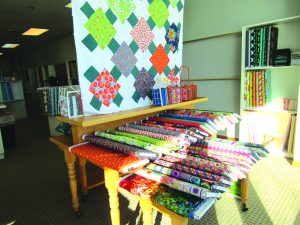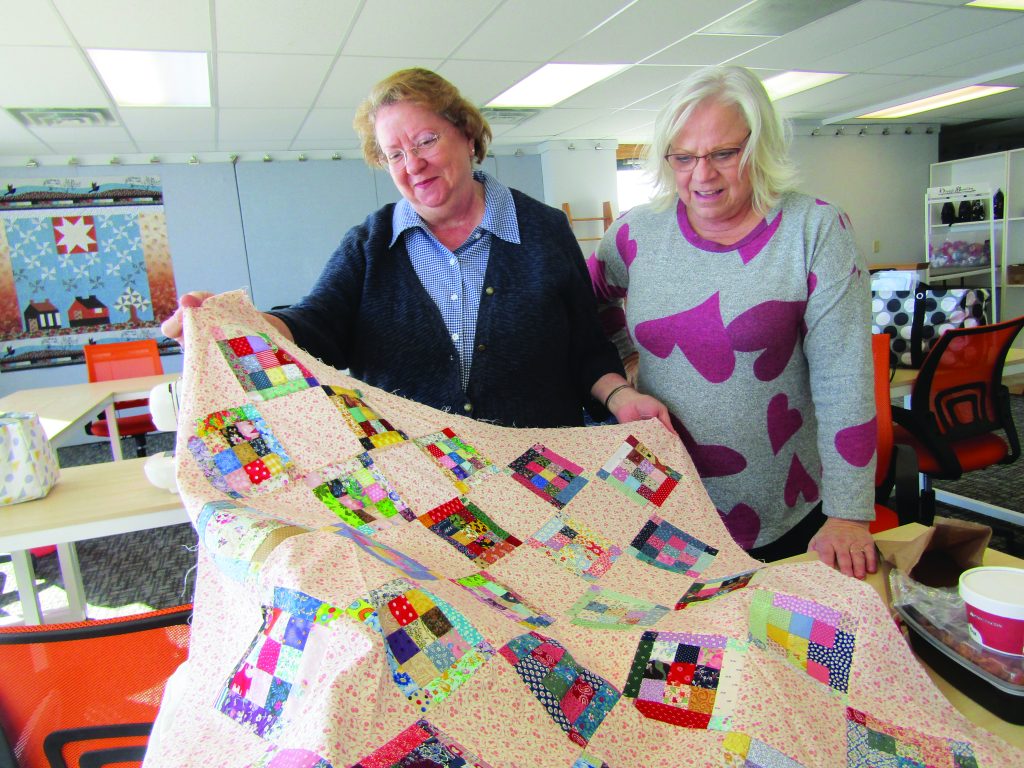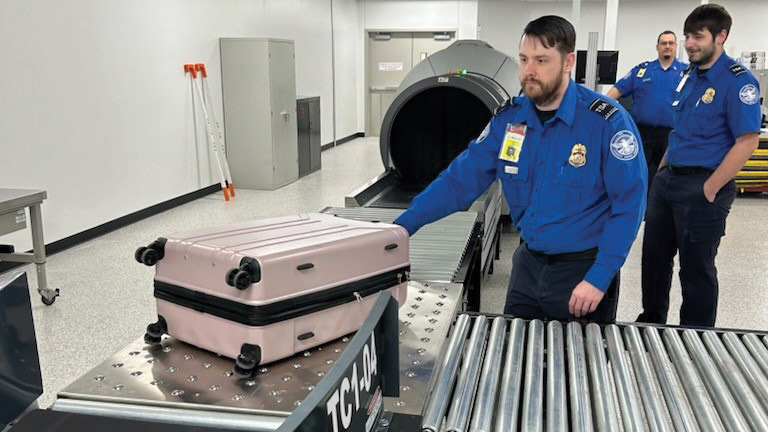Quilters Melody Sawvell of McCausland, Iowa, and Becky Kummer of Davenport are often busy having fun and creating quilting art.
The friends are part of a sewing group that meets at the new Orange Blossom Stitchery & Quilt Shoppe in LeClaire to work on quilts.
Ms. Kummer, who completes about six quilting projects a year, was busy working on a quilt pattern called the Rock Island Campfires. “If I sew with others, I seem to get a lot more done when I’m in a group,” she said, adding that she attends a sewing event at the Orange Bloom about once a week.
Orange Blossom’s owners say business is going well, but they are always looking to make improvements. That’s because these are changing times for the quilting industry. Many in the industry are facing a patchwork of challenges and economic changes but also even greater opportunities for the community of quilters.
In some cases, local businesses have suffered as quilters have tightened their belts in face of inflation and tougher economic times. Some face the familiar problem of finding good employees in an era when bigger businesses can pay workers a lot more money. And some traditional storefront quilt supply shops are losing business to online options.
Still, others in the business report there is room to grow, and they are optimistic about the quilting future.
Among those who are optimistic about the future are Laura Strickland and Amanda Norris, owners of the new Orange Blossom Stitchery & Quilt Shoppe at 208 S. Cody Road, LeClaire. Their business opened last summer.
Ms. Strickland said business is going “fairly well” now after scrambling to get the needed quilting supplies in the early days of the business. “We’ve been growing and people come in here and say we’ve made good choices,” she added.
One of the keys to success is offering top-quality customer service. Ms. Strickland gave the example of a customer coming into Orange Blossom to buy one spool of thread. The owner will spend extra time with that customer to find out what project she is working on to make sure the customer gets the right spool for her project. The goal is to make sure that person returns to the business and becomes a loyal customer.
“You have to have a good reputation. … That will build loyalty,” Ms. Strickland said.
Others factors helping build the new business include:
- Offering high-quality, unique items that can’t be found in other quilting shops. In fact, if a customer can’t find an item for a quilting project, Ms. Strickland and Ms. Norris will direct them to other quilting businesses that carry those supplies.
- Offering a wide variety of classes for quilters. “We are class heavy, being education minded,” Ms. Strickland said, adding that the shop’s classroom was put in the front of the building, near big windows so quilters can enjoy the good lighting and perhaps spur their creativity.
- Preparing for the future. Part of that preparation is welcoming customers who don’t fit into that traditional quilter demographic. Ms. Strickland said that there has been “a surge in the last 10 years” of younger women and even some men joining the ranks of quilters. Orange Blossom also is considering expanding its business by starting a subscription box service for customers. If this eventually happens, customers would pay to have quilting supplies and other goodies sent to them.
Quilting more than a fad
Another reason the LeClaire business owners are optimistic hinges on quilting itself. They said quilting is not a fad that will come and go; the activity is here to stay.
Also, quilting will remain popular because it inspires creativity. “Doing anything creative is healing. … Your body will actually heal,” said Ms. Strickland.
While most people in local quilting businesses agree quilting will remain popular, getting in – or staying in – the quilting business can be an entirely different matter.
For instance, Sara Guerrero, owner of Our Crafty Life LLC in Geneseo, Illinois, also offers many quilting supplies, classes, quilting patterns and other services at her storefront. But adds these are slow times for her business. Part of that is because of a normal business slowdown after the holidays, but also because many people are now getting their quilting supplies and lessons online.
“People are moving toward social media. … People don’t see you as much,” she said.
Ms. Guerrero added her quilting business has been greatly helped through selling quilts and supplies on the online marketplace Etsy.
Her hope is that there is more cooperation and collaboration between quilting businesses that will help keep all the businesses open. If that doesn’t happen, she adds, many of today’s quilting storefront businesses may close because customers are getting their quilting supplies online.
Some quilters are closing up shop
One northern Illinois quilting business that just closed its brick-and-mortar store is the Lucky Quilt Company in Pecatonica, located about 115 miles northeast of the Quad Cities. That store closed at the end of January, but is still doing business online.
Cassie Blair, the store’s owner, said her decision was based on several factors, including declining storefront sales because many shoppers are getting supplies online, and the continuing struggle to find employees. She lost three key employees just last year.
“It just zaps your energy. This is just exhausting. … I’ve just run out of energy to do this,” Ms. Blair told the QCBJ.
She added that there is an irony to her situation. She is closing her storefront building during an era in which she believes quilting is becoming extremely popular. “Quilting is definitely on the upswing. The younger generation is getting into it,” she added.
Stephanie Soebbing, of Rock Island, is part of that younger generation getting into quilting. The 38-year-old woman took a passionate hobby and turned it into a business – Quilt Addicts Anonymous – almost 10 years ago.
Quilt Addicts Anonymous became a juggernaut of everything associated with quilting – selling supplies, video lessons on quilting, a subscription service of quilting supplies and packages, opening a quilting storefront business, selling patterns and much more.
“I started quilting after college because I was bored. I was used to working 30 hours a week at the student newspaper, interning at the local paper, TV or radio station, maintaining a full class load and a full social calendar. Just having to work 40 hours a week wasn’t enough. At that time, really not that long ago, there weren’t that many good tutorials on the web for quilters getting started. I seriously sewed with a regular presser foot for a year and didn’t realize why I sewed a consistent three-eighths-inch seam until I finally took my first quilting class. From then on I was addicted. I took one or two classes a month, trying out every technique I could until I got to the point where I was good enough to start teaching my own classes,” Ms. Soebbing wrote on her company website.
The Quilt Addicts Anonymous business continued to move forward and grow. She had a team of 14 people working for her, the bills were being paid, money was being made and it was all a “well-oiled machine,” she said.
But times changed. A big part of those changes could be seen in the ever-growing interest rates. The Fed has raised interest rates 11 times since March 2022. The spike in rates caused consumer borrowing costs to skyrocket while inflation remained elevated, putting many households under pressure.
Even some larger brick and mortar stores have felt the squeeze. Popular fabric and craft store Joann Fabric is facing financial uncertainty after declining sales and heavy debt decreased its recent CreditRiskMonitor FRISK Score to 1.
And that financial pressure meant many people cut down on expenses they consider a luxury – like quilting.
Quilters are cutting back
“It’s hard in general. People are crunching their budgets,” said Ms. Soebbing.
She added that interest rate hikes and inflation have had a profound impact on her quilting business. Her customers stopped buying supplies and her subscription service numbers took a big drop. Ms. Soebbing decided to close Quilt Addicts Anonymous’ brick-and-mortar store in Rock Island last fall.
“The current economic conditions have made it difficult for many of our customers to purchase fabric at the same rates as they did previously, so we couldn’t support fabric sales any longer,” she posted on her business’ Facebook page.
In an interview with the QCBJ, Ms. Soebbing added she is also in the process of filing for bankruptcy because of those changing economic conditions.
In addition to the changing economics, many people are also pressed for time. Some no longer have the time for quilting projects. (Ms. Soebbing said she learned this big lesson early in her business career: Buying fabric and doing something with it are two separate activities.)
However, other portions of the business remain open. She is continuing to sell patterns and still offering the e-learning side of the business. Also, in May she will be teaching on a 13-night Transatlantic Quilting Cruise to western Europe and the UK. She also will have a book on quilting – called “Quilting With Panels Throughout the Year” – scheduled to be published in the spring of 2025.
Even though Ms. Soebbing says these are crazy, changing times in the quilting business, she still loves quilting and is looking forward to the future. “I’m excited about what’s coming in the future. I’m just not sure what that is yet,” she added.
She did offer this advice for people considering getting into the business:
- Build your customer list first with social media and email. Don’t just open a shop and hope people will come.
- Start small and do it without debt.
- Reinvest the profits to grow instead of taking on financing.
Brick-and-mortar shops “are a dreamy idea, but they take a lot of money and time to run. You also have to bring in a significant amount of fabric to make it look full. You might do better selling to an online audience only,” she said.
Ms. Soebbing also offered this advice to potential businesspeople, stating it was one of the things she wishes she could have done differently: “I wish when things started to turn, I would have reduced expenses rather than take on additional funding. I thought we were dealing with a temporary downturn that we could weather. But I was very wrong and the payments for the additional funding are what eventually took us down.”
Even though the business of quilting is changing and has mixed fortunes for many business owners, the activity of quilting still has a solid base in the region, according to the quilters who attend sewing sessions at the Orange Blossom Stitchery & Quilt Shoppe.
“It’s fun taking all these little fabric pieces, cutting them up and making something beautiful out of them. …“It’s a fun thing to do. It’s really therapeutic,” Ms. Sawvell said.









